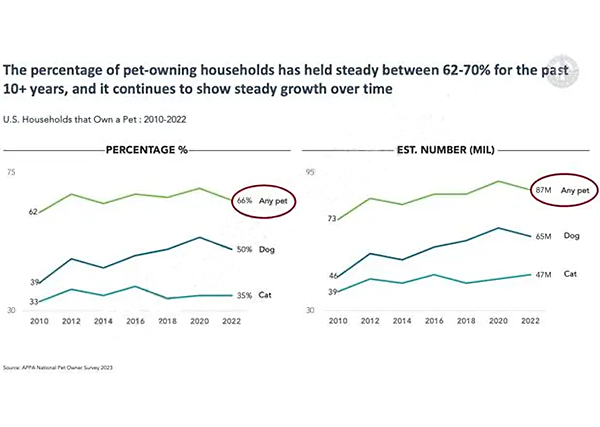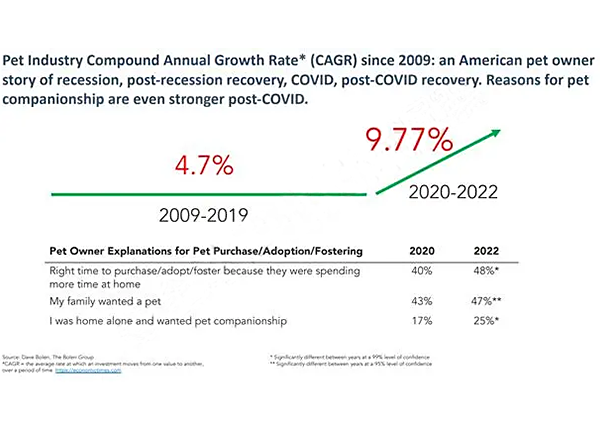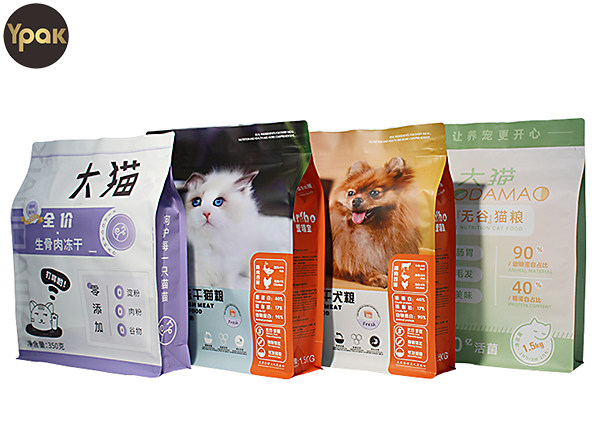New business opportunities in the US pet packaging market.
In 2023, the American Pet Products Association (hereinafter referred to as "APPA") released the latest report "Strategic Insights for the Pet Industry: Pet Owners 2023 and Beyond". The report provides additional insights into the National Pet Owners Survey (NPOS), providing a detailed analysis of statistical differences, generational trends, and more in the pet industry.


Household pet ownership rates: 2022, according to APPA report ↓
66% of U.S. households own pets, a 4% increase from 62% in 2010, meaning approximately 172.24 million adult consumers live in households with pets.
It also shows that pet ownership rates have remained stable despite financial and economic concerns. However, it is worth noting that the proportion of multi-pet households (those with two or more pets) has steadily increased over the past few years.
An estimated 66% of pet-owning households own multiple pets, a 3% increase from 63% in 2018.
Multiple pet ownership in households: According to APPA, the increase in the proportion of U.S. pet-owning households with multiple pets from 2018 to 2022 can be attributed almost entirely to Generation Z and Millennial households, of which nearly three-quarters are multi-pet households. . 2022, by generation↓
◾ Generation Z: 71% of households have multiple pets, an increase of 5% from 66% in 2018;
◾ Millennials: 73% of households have multiple pets, an 8% increase from 67% in 2018;
◾ Generation X and Baby Boomers: Much lower rates of multiple pet ownership.


Projections for pet ownership indicate continued success for the industry.
Because APPA predicts that 69% of American households will own pets in 2024, but by 2028, the pet ownership rate is expected to decline slightly, with only 68% of households owning pets.
Number of pet-owning households: While there may be a slight "yo-yo" effect on household pet ownership, the actual number of pet-owning households in the U.S. will remain strong.
APPA’s report shows that in 2022↓
◾ Households with pets: 87 million, up from 73 million in 2010;
◾ Households with dogs: 65 million, up from 46 million in 2010;
◾ Households with cats: 47 million, up from 39 million in 2010.
Expected to be by 2024↓
◾ Households with pets: will reach 9,200;
◾ Households with dogs: will reach 69 million;
◾ Households with cats: will reach 49 million households.
Expected to be by 2028↓
◾ Households with pets: will reach 95 million;
◾ Households with dogs: will reach 70 million;
◾ Households with cats: will reach 49 million households.
Popular pets: Dogs and cats remain the most popular pets in the United States.
2022↓
◾ 50% of households: keep dogs;
◾ 35% of households: keep cats.
APPA predicts that the ratio of cats to dogs in the United States will remain stable in the next few years.
Expected↓
◾2024: 52% of households will have dogs and 36% of households will have cats;
◾2028: 50% of households will have dogs and 36% of households will have cats.


Number of household pets: According to the 2023-2024 APPA survey of pet owners, the number of dogs, cats, and freshwater fish occupy the top three. 2022↓
◾ Dogs: 65.1 million
◾Cats: 46.5 million
◾ Freshwater fish: 11 million
◾ Small animals: 6.7 million
◾ Birds: 6.1 million
◾ Reptiles: 6 million
◾ Ocean fish: 2.2 million
◾ Horses: 2.2 million
Consuming behavior
According to Bloomberg Intelligence, the global pet industry will grow to US$500 billion by 2030.
Among them, the US pet market accounts for "half of the country".
Pet Spending: As the number of pets continues to increase, sales in the pet industry have been booming for years and will continue to grow.
APPA’s report shows↓
◾ Pet owner spending grew from $46 billion in 2009 to $75 billion in 2019, with a compound annual growth rate (CAGR) of 4.7%.
◾ Expenditures in 2020 will reach US$104 billion and will exceed US$137 billion in 2022, with a compound annual growth rate of 9.7%.


According to APPA’s forecast, the industry’s sales are expected to be ↓
◾ 2024: Reaching US$171 billion;
◾ 2030: Reaching US$279 billion.
In this forecast, pet food will account for the largest share and is expected to be by 2030↓
◾Pet food: will reach approximately US$121 billion;
◾ Veterinary care: $71 billion;
◾ Pet supplies and over-the-counter drugs: $66 billion;
◾ Other services including live animal sales: $24 billion.
Purchase products: According to APPA, pet owners will mainly spend money on pet food and products in 2022, including pet beds, pet cages, carriers, chews, grooming aids, safety belts, medicines, food accessories, toys and Vitamins and supplements.
The above data can be concluded that the pet industry is developing strongly in the United States, driving the demand for pet product packaging to surge. In an era of rapid market growth, how to make our pet product packaging stand out so that customers can buy and use it with confidence. This is something we need to think about.
We are a manufacturer specializing in producing the food packaging bags for over 20 years. We have become one of the largest food bag manufacturers in China.
We use the best quality PLALOC brand zipper from japan to keep your food fresh.
We have developed the eco-friendly bags, such as the compostable bags、recyclable bags and PCR material packaging. They are the best options of replacing the conventional plastic bags.
Attached our catalogue, please send us the bag type, material, size and quantity you need. So we can quote you.

Post time: Apr-19-2024







